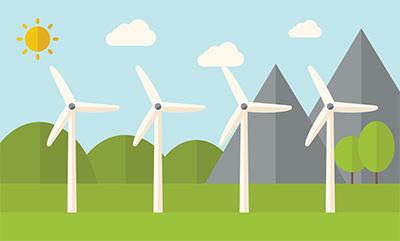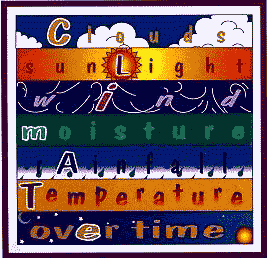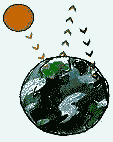Let's Talk About — Atmosphere and Health
Have you ever wondered about the sky above you? When you look upward, you are seeing part of the Earth's atmosphere. The atmosphere is the layer of air around the Earth. Air contains nitrogen, oxygen, and other gases like carbon dioxide, water vapor and ozone.
Almost all the gas around our planet is in a thin layer that is about 60 miles high. This is the same distance that you might travel on a highway if you drove for an hour.
Energy from the Sun
Have you ever noticed how warm a car can get inside when it's parked in the sun? Light energy from the sun goes through the windows and is trapped as heat inside the car. The same thing happens on Earth, except that some gases, like carbon dioxide, act like the car windows and hold heat inside. It's a good thing that they do, because otherwise Earth would be a lot colder! The only problem is that we are putting extra heat-trapping gases into the atmosphere. This might make the Earth get warmer.
What is Climate?
If the Earth gets even a little bit hotter, the climate in many different parts of the world could change. Some places would get warmer and drier. Other places might get more rain. This would affect farms, forests, wildlife—just about everything on the planet.
The Greenhouse Effect
- Sunlight passes through the clear atmosphere and warms the Earth's surface.
- The Surface gives off some heat that goes back into the atmosphere. Some of it passes through and escapes into space.
- Greenhouse gases and water vapor trap some of the heat and give it off again toward the Earth.
The Atmosphere is Special
The atmosphere protects us from dangerous rays produced by the sun. We can see part of the energy from the sun as light, and feel part of it as heat. But the sun also sends out other kinds of energy. Some of these, like ultraviolet—or UV rays, can be harmful to living things. UV radiation makes your skin turn red it you are in the sun too long. UV rays also cause skin cancer in people if they are in the sun too much. A gas in the atmosphere, called ozone, soaks up almost all of the UV rays from the sun, but some still get through.
Whoops!
Some chemicals we use go up into the atmosphere and destroy part of the layer of ozone that protects us from UV radiation. Most of these are CFCs. CFC stands for chlorofluorocarbon (KLOR-oh-FLOR-oh-KAHR-buhn). These chemicals can be used in air conditioners, refrigerators and some aerosol cans. Almost all countries on Earth have agreed to stop putting CFCs into the atmosphere.
Fossil Fuels
Fossil fuels, like coal and gasoline, come from plants that died millions of years ago. These plants took in carbon dioxide from the air during photosynthesis. When we burn fossil fuels today, carbon dioxide goes back into the atmosphere.








